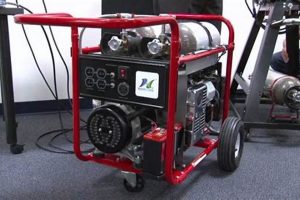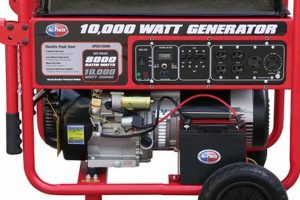Proper preservation of a compact, transportable power source involves safeguarding it from the elements and maintaining its operational readiness for future use. This typically entails selecting a suitable location, employing protective measures against moisture and pests, and adhering to manufacturer guidelines for fuel and battery upkeep.
Preserving a generator in optimal condition ensures its reliability during power outages or remote activities. Neglecting proper procedures can lead to fuel degradation, mechanical issues, and reduced lifespan, potentially rendering the unit unusable when needed most. Historically, generators have played a crucial role in emergency preparedness and off-grid power supply, underscoring the significance of maintaining their functionality.
Key aspects of generator preservation include location selection, weather protection, fuel stabilization, battery maintenance, and periodic operational testing. These considerations will be examined in detail to provide a comprehensive guide for ensuring long-term reliability and performance.
Tips for Generator Preservation
Proper storage ensures generator reliability and longevity. The following tips provide guidance for maintaining a generator in optimal condition.
Tip 1: Choose a Dry, Well-Ventilated Location: Damp environments promote rust and corrosion. A shed, garage, or covered area with adequate airflow is ideal. Avoid storing units directly on the ground; elevate them on a wooden pallet or platform.
Tip 2: Empty or Stabilize Fuel: Fuel left in the tank can degrade over time, leading to starting difficulties and engine damage. Either drain the fuel completely or add a fuel stabilizer according to manufacturer instructions.
Tip 3: Disconnect the Battery: Batteries can discharge during storage. Disconnecting the battery cables prevents this and prolongs battery life.
Tip 4: Protect from Pests: Rodents and insects can damage wiring and other components. Cover the generator with a breathable cover and consider using rodent repellents around the storage area.
Tip 5: Perform Regular Maintenance: Even during storage, generators benefit from periodic checks. Every few months, inspect the unit for signs of damage, check oil levels, and run the generator briefly to circulate the oil and ensure proper function.
Tip 6: Consult the Manufacturer’s Manual: Always refer to the specific instructions provided by the manufacturer for detailed storage recommendations tailored to the particular generator model.
Tip 7: Keep the Area Clean and Organized A clutter-free storage area helps prevent accidental damage to the generator and makes routine maintenance easier.
Adhering to these guidelines ensures a generator remains ready for use when needed, maximizing its lifespan and providing reliable power during emergencies or other essential applications.
By understanding and implementing these storage practices, users can significantly enhance the longevity and dependability of their generators.
1. Location
The location chosen for generator storage significantly impacts its longevity and operational readiness. A suitable environment mitigates the detrimental effects of weather, pests, and accidental damage. Storing a unit in a damp, poorly ventilated area, for instance, promotes rust and corrosion, potentially affecting the engine, fuel system, and electrical components. Conversely, a clean, dry, and well-ventilated space, such as a garage or shed, safeguards the generator from these hazards. Elevating the unit off the ground using a pallet further protects it from moisture and pests.
Considering proximity to the home is also crucial. While convenient access is desirable, storing a generator too close to living spaces poses safety risks, particularly concerning exhaust fumes during operation. A detached shed or garage offers the best compromise between accessibility and safety. Furthermore, the chosen location should be secure to deter theft and vandalism. A locked storage area provides an additional layer of protection against unauthorized access.
Careful location selection is therefore an integral aspect of responsible generator ownership. Choosing an appropriate environment safeguards the unit from damage, preserving its functionality and ensuring its readiness for emergencies or planned use. Neglecting this crucial factor can lead to costly repairs, reduced lifespan, and potential safety hazards. Prioritizing proper storage location contributes significantly to the long-term reliability and value of the investment.
2. Fuel
Fuel management is a critical aspect of portable generator storage. Gasoline left within a generator’s fuel system during storage can degrade, leading to several potential issues. Oxidation and varnish formation can clog carburetors and fuel lines, hindering engine starting and performance. Furthermore, stale fuel can attract moisture, contributing to corrosion within the fuel system. These effects are exacerbated by higher storage temperatures and prolonged storage periods. For instance, a generator stored with a full tank of untreated gasoline over the winter months might experience starting difficulties or require carburetor cleaning in the spring.
Two primary approaches address these challenges: fuel stabilization and fuel removal. Fuel stabilizer additives prevent oxidation and varnish formation, extending the storage life of gasoline. Following manufacturer recommendations for stabilizer type and dosage is essential for optimal results. Alternatively, completely draining the fuel system, including the tank, carburetor, and fuel lines, eliminates the risk of fuel degradation. This method, while more time-consuming, offers the most comprehensive protection against fuel-related issues during storage. In either case, consulting the generator’s owner’s manual for specific fuel-related storage instructions provides tailored guidance.
Proper fuel management during storage directly impacts a generator’s reliability and lifespan. Neglecting this critical element can result in costly repairs, diminished performance, and frustration when the generator is needed most. Employing either fuel stabilization or fuel removal practices, informed by manufacturer guidelines, ensures optimal preservation of the fuel system and contributes to the generator’s long-term operational readiness.
3. Battery
Battery maintenance is essential for portable generator storage. A generator’s battery serves two primary functions: starting the engine and powering essential electrical components, such as control panels and charging systems. Leaving a battery connected during prolonged storage periods leads to self-discharge, potentially rendering the battery unable to perform these functions when needed. Temperature fluctuations exacerbate this discharge, shortening the battery’s lifespan. For example, a generator left idle over the winter with the battery connected might not start in the spring due to excessive battery drain.
Disconnecting the battery cables mitigates this issue. Removing the negative cable first, followed by the positive cable, prevents accidental short circuits. Storing the battery in a cool, dry place further minimizes self-discharge and extends its life. Periodically checking the battery’s charge level during storage, especially in colder climates, allows for timely recharging if necessary, ensuring the generator remains ready for use. Furthermore, some generators feature electric start systems dependent on a charged battery for operation, highlighting the importance of battery maintenance for overall generator functionality.
Proper battery care during generator storage directly impacts the unit’s reliability and lifespan. Neglecting this aspect can lead to starting failures, reduced operational efficiency, and premature battery replacement. Disconnecting the battery and ensuring proper storage conditions safeguards against these issues, preserving the battery’s functionality and contributing to the generator’s long-term operational readiness. This practice, combined with other preventative maintenance measures, ensures the generator remains a dependable power source whenever required.
4. Protection
Protection plays a vital role in preserving a portable generator’s condition and functionality during storage. Several environmental factors and potential hazards necessitate protective measures. Weather exposure, particularly moisture and extreme temperatures, can cause corrosion, rust, and damage to sensitive components. Pests, such as rodents and insects, can chew through wiring, nest within the unit, and compromise its operational integrity. Accidental damage from falling objects or impacts can also occur during storage, especially in cluttered or poorly organized spaces. For example, storing a generator outdoors without a cover exposes it to rain, snow, and temperature fluctuations, potentially leading to rust and electrical malfunctions. Similarly, storing a unit in a shed infested with rodents invites damage to wiring and internal components.
Several practical measures provide effective protection during storage. Utilizing a weatherproof cover shields the generator from rain, snow, and excessive sunlight. Elevating the unit off the ground using a pallet or platform protects it from moisture and pests. Storing the generator in a secure, enclosed space, such as a locked shed or garage, safeguards it from theft, vandalism, and accidental damage. Furthermore, applying rodent repellent around the storage area deters pests and prevents infestations. Regularly inspecting the generator for signs of damage, pests, or corrosion allows for timely intervention and prevents minor issues from escalating into major problems.
Comprehensive protection against potential hazards is crucial for maintaining a generator’s operational readiness and extending its lifespan. Neglecting protective measures can result in costly repairs, diminished performance, and potential safety risks. Implementing practical safeguards ensures the generator remains in optimal condition during storage, providing reliable power when needed. This proactive approach to protection represents a crucial aspect of responsible generator ownership and contributes significantly to the unit’s long-term value and dependability.
5. Maintenance
Regular maintenance is integral to the proper storage of a portable generator and significantly impacts its long-term reliability. While storage aims to preserve the unit’s condition, neglecting ongoing maintenance can undermine these efforts. Maintenance during storage differs from operational maintenance; it focuses on preventing deterioration and ensuring the generator remains ready for use when needed. For instance, failing to change the oil before extended storage can lead to oil degradation, potentially harming the engine. Similarly, neglecting to check for rodent activity might result in damaged wiring or nests within the unit, requiring costly repairs.
Several maintenance tasks are crucial during generator storage. Changing the oil and filter according to manufacturer recommendations prevents sludge formation and protects internal engine components. Adding fuel stabilizer or draining the fuel system mitigates fuel degradation and potential clogging issues. Inspecting and cleaning the air filter ensures proper airflow when the generator is started. Checking spark plugs and replacing them if necessary contributes to efficient combustion. Lubricating moving parts and inspecting for signs of corrosion or damage further safeguards the unit’s integrity. These preventative measures ensure the generator remains in optimal condition, minimizing the risk of malfunctions when called upon.
Effective generator storage necessitates a proactive approach to maintenance. Integrating these practices into a comprehensive storage plan ensures the generator’s longevity, reliability, and operational readiness. Neglecting maintenance during storage can lead to costly repairs, reduced performance, and potential safety hazards. Prioritizing these preventative measures contributes significantly to the long-term value and dependability of the generator, ensuring it remains a reliable power source when needed.
Frequently Asked Questions
This section addresses common inquiries regarding portable generator storage, providing concise and informative responses to clarify potential uncertainties and promote best practices.
Question 1: How often should a stored generator be run?
Running a stored generator briefly every two to three months helps lubricate internal components, prevent fuel system issues, and identify potential problems early. Consult the manufacturer’s manual for specific recommendations.
Question 2: Is it necessary to use a fuel stabilizer?
Fuel stabilizer prevents gasoline degradation during storage, extending its lifespan and preventing engine issues. While draining the fuel system is an alternative, using a stabilizer offers greater convenience for most users.
Question 3: Can a portable generator be stored outdoors?
While not ideal, outdoor storage is possible with adequate protection. A weatherproof cover, elevated platform, and secure location are essential to mitigate weather damage, pest intrusion, and theft.
Question 4: What are the risks of improper generator storage?
Improper storage can lead to fuel degradation, battery failure, corrosion, pest infestations, and starting difficulties. These issues can necessitate costly repairs and reduce the generator’s lifespan.
Question 5: How should the battery be handled during storage?
Disconnecting the battery cables, preferably starting with the negative cable, prevents battery drain during storage. Storing the battery in a cool, dry place further prolongs its lifespan.
Question 6: Where can specific storage instructions for a particular generator model be found?
The manufacturer’s manual provides detailed storage instructions tailored to the specific generator model. Consulting this resource is crucial for ensuring optimal preservation.
Proper generator storage is essential for maintaining its reliability and longevity. Adhering to manufacturer guidelines and implementing the practices outlined above ensures the unit remains a dependable power source when needed.
For further information on generator operation and maintenance, consult the resources available on the manufacturer’s website or contact qualified service personnel.
Storing a Portable Generator
Proper storage of a portable generator is paramount for ensuring its reliability, longevity, and operational readiness. This comprehensive guide has explored crucial aspects, including location selection, fuel management, battery care, protective measures, and ongoing maintenance. Each element contributes significantly to preserving the generator’s functionality and preventing potential issues that can arise from improper storage practices. From mitigating fuel degradation and battery drain to safeguarding against weather damage and pest infestations, proactive measures ensure the generator remains a dependable power source when needed.
Investing time and effort in proper generator storage yields substantial returns in terms of performance, lifespan, and overall value. A well-maintained generator provides peace of mind, ensuring access to reliable power during emergencies or planned use. By adhering to the guidelines and recommendations presented herein, generator owners can confidently rely on their units to perform optimally when called upon, maximizing their investment and ensuring preparedness for any power contingency.






